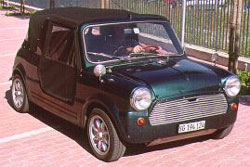The electric-drive
Evergreen -
evocative of the classic
BMC Mini -
was developed in the 1990s in Ibach,
Switzerland by Andreas Klasen and the the firm COMminiCATION. It used some of the mechanical components
of the original Mini to reduce development costs.
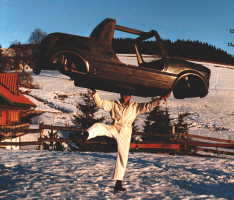 The Evergreen was built with a self-supporting lightweight fiberglass composite body. Thanks to simple
design - a cabrio / targa body with cloth top and doors - all up the basic vehicle weighed only 330kg (725lb).
Yet it was able to carry a battery of up to 470kg - a remarkable 140% of its own weight.
The Evergreen was built with a self-supporting lightweight fiberglass composite body. Thanks to simple
design - a cabrio / targa body with cloth top and doors - all up the basic vehicle weighed only 330kg (725lb).
Yet it was able to carry a battery of up to 470kg - a remarkable 140% of its own weight.
This allowed for a range of around 120km (75 miles), even with a cheap, simple lead battery. With 470kg of
today's advanced lithium EV batteries, an Evergreen could achieve over 500km (310mi) of range. Alas,
COMminiCATION stopped building the Evergreen in the early 2000s.
In the mid-1990s, Alex Krause of Brusa Elektronik AG, a Swiss EV components designer and manufacturer founded in
1985, scored one of the few existing copies of this featherweight EV. He fitted it with what was then Brusa's largest
liquid-cooled motor, their most powerful inverter (AMC-325), and a 180 volt, 100 amp-hour (18kWh) battery made
of liquid-cooled Saft nickel-cadmium EV modules. As of 2001, he had driven it over 80,000km with essentially no
decline in battery capacity.
In 1997, Krause took his Evergreen from Gams to Stabio for a business meeting - a distance of 220km (132mi). He made
the journey with no charging stops, though he did charge during his meeting at Stabio. This would be a more than
respectable accomplishment for any EV of that vintage, but this trip involved crossing the Alps. The car had to
climb 1140m, descend 1350m, and then reverse the elevation change to return.
The following description of the car and the journey is adapted from one published by Brusa in the early 2000s.
Axel Krause
BRUSA Elektronik AG
Neudorf 14
Postfach 55
CH-9466 Sennwald
Schweitz
Historic Crossing of the Alps on 18 August 1997
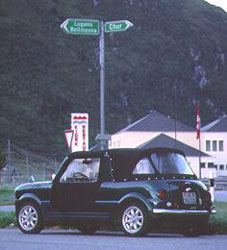
We started in Gams around 0630 with a fully charged battery. It was dark for the first two hours of the drive, so that we had to
use about 2% of the battery capacity for the headlights.
We reached the San Bernardino tunnel entrance at sunrise. By that time, we had already used 74% of the battery capacity and
had covered just over half the route.
On the first part of the steep descent, we were able to recover about 5% of the total battery capacity through recuperation.
From kilometer 140, the downward gradient was less, so that we could cover the next 20 km without appreciable consumption.
Thanks to the recuperation, we reached Bellinzona, the lowest-altitude point of the journey, with the same amount of energy
in the battery as at the San Bernardino Tunnel. This means that we covered approximately 50 km essentially without consuming
any energy.
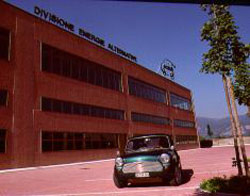
In Stabio, we charged during a meeting with a business partner. Thanks to the 10 kW charger, the battery was fully charged
in 2 hours. During the return journey, again we needed no intermediate charging. This was thus the first time in history that an
electric vehicle crossed the Alps from one valley to another, without any intermediate charging -- and, at that, twice on
the same day.
Graphic Representation of the Trip
The graph shows the deviation of the battery ampere hour status from the 0.4477 ah/km average we would expect if
we covered the same route in flat terrain. The X axis is the distance in km, and the Y axis is the deviation from
flat-terrain consumption. The green line represents the journey from Gams to Stabio (read left to right), and the
red line is the return trip (read right to left).
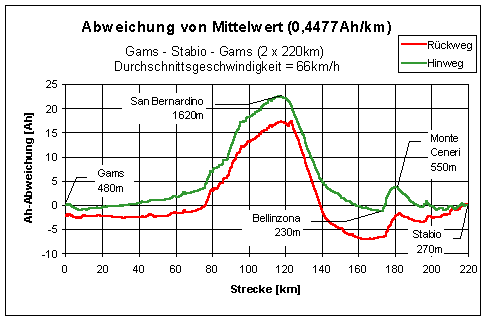
From this curve, we can conclude that:
- The curve is virtually identical with the altitude. If the graph showed kWh rather than Ah, the
correspondence would be even better.
- Range is not significantly affected by mountain driving. Essentially the entire potential energy difference can
be recovered by regenerative braking and by coasting when possible.
- Nonetheless for optimal range, the mountainous portion of a long journey should not be at or near the journey's
end.
On the return trip, the energy consumption was extremely low for the first 60 km. This was because of a strong tail wind and an
air temperature that was 15 degrees celsius warmer. In addition, the battery temperature was about 15 degrees higher during the
second ride, and that meant a lower internal battery resistance.
During the charging in Stabio, the batteries required 23.5 kWh from the mains. That corresponds to a very low energy
consumption of only 10.7 kWh / 100 km, roughly equal to a petrol consumption of one litre per 100km.
Technical Information
| Chassis and suspension |
- Self-supporting fiberglass body
- Galvanized steel subframe in front
- Front and rear knee action suspension
- In front: Double control arm with rubber spring and pneumatic shock absorbers
- In rear: Trailing arm with coil springs and pneumatic shock absorbers
- Direct activated drum brakes in front and rear
- Rack-and-pinion steering, 2.75 turns lock to lock
|
| Body, weights |
- Cabriolet body with cloth top and 2 cloth doors
- Heatable laminated glass windshield
- 4 seats
- Curb weight including batteries: 900kg
- Gross Vehicle Weight Rating: 1200kg
|
| Sizes |
- Length: 3030mm
- Width: 1410mm
- Height: 1300mm
- Wheelbase: 2050mm
- Track front/rear: 1260mm
- Ground clearance: 140mm
- Tyres: 145/60 R13 (summer) or 145/70 R13 (winter)
|
| Motor with inverter |
- Water-cooled three-phase induction motor with IGBT inverter
- Nominal input voltage: 180 Volt DC
- Maximum traction current: 250 Amp. DC
- Maximum regenerative braking current: 100 Amp. DC
- Maximum effective motor output current: 3 x 250 Amp.
- Maximum power: 36kW (49hp) at 3500rpm
- Power bandwidth: 20kW (27hp) at any speed from 2000 to 9500rpm
- Maximum torque: 120Nm from 0 to 2800rpm
- Maximum rotation speed: 10,000 rpm
- Maximum efficiency: 91% including inverter at 5000rpm, 12kW
- Typical efficiency: Over 85% at any speed from 2500 to 7200rpm, 20kW
- Motor weight, dry: 46kg
|
| Drive |
- Double-stage parallel-shaft gearbox with integrated differential
- Drive to front wheels by universal joint shafts
- Total reduction gear: 7 : 1
- Speed at motor speed of 1000rpm: 13.3 km/h
|
| Battery |
- Water-cooled flooded NiCd modules with central watering system
- 30 blocks of 6V/100Ah (SAFT STM 5-100 MRE)
- Total nominal voltage:180V
- Capacity (3h): 100Ah
- Weight including cooling and watering system: 400kg
- Service life (factory data): 1200 cycles
- Maintenance interval (watering): 10,000km
|
| Battery charger |
- Water-cooled HF-switching type automatic onboard charger
- Charging power from mains:
- 0 - 3.6kW single-phase; 230VAC
- 0 - 11kW three-phase; 3 x 230/400VAC
- Typical charging time from 100% DOD: 12h using a 10A supply to 100% charge
- Shortest charging time from 100% DOD: 2h using a 3x16A CEE supply to 90% charge
- Efficiency: 92% mains to battery
|
| Performance, consumption |
- Maximum gradient: 24% with full load
- Top speed: 125km/h
- Acceleration 0-50km/h: 6s
- Acceleration 0-80km/h: 12s
- Consumption from mains:
- 11.0kWh / 100km economical long-distance journey
- 12.5kWh / 100km mean value in summer
- 16.5kWh / 100km mean value in winter, no heating
- 20kWh / 100km mean value in winter, with heating
- Range with 1 charge:
- 220km in summer, rural roads, average 65km/h
- 160km in winter, without heating
- Total efficiency: approximately 60% from the mains plug to the wheels
|


 The Evergreen was built with a self-supporting lightweight fiberglass composite body. Thanks to simple
design - a cabrio / targa body with cloth top and doors - all up the basic vehicle weighed only 330kg (725lb).
Yet it was able to carry a battery of up to 470kg - a remarkable 140% of its own weight.
The Evergreen was built with a self-supporting lightweight fiberglass composite body. Thanks to simple
design - a cabrio / targa body with cloth top and doors - all up the basic vehicle weighed only 330kg (725lb).
Yet it was able to carry a battery of up to 470kg - a remarkable 140% of its own weight. 